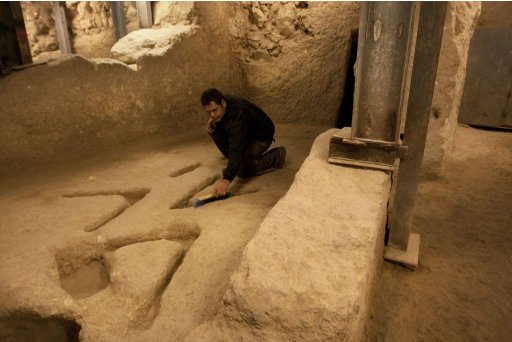Researchers say they've found two pits to the east and west of Stonehenge that may have played a role in an ancient midsummer ceremony. The discovery suggests that the 5,000-year-old circle of stones we see today may represent just a few of the pieces in a larger geographical, astronomical and cultural puzzle.
The previously undetected pits could provide clues for solving the puzzle.
"These exciting finds indicate that even though Stonehenge was ultimately the most important monument in the landscape, it may at times not have been the only, or most important ritual focus, and the area of Stonehenge may have become significant as a sacred site at a much earlier date," Vince Gaffney, an archaeology professor at the University of Birmingham, said in a news release issued over the weekend.
The pits, which measure about 16 feet (5 meters wide) and at least 3 feet (1 meter) deep, have been covered over for centuries and can't easily be spotted on the ground. But they showed up in a survey that was conducted using non-invasive mapping techniques such as ground-penetrating radar and magnetometry. The survey is part of the Stonehenge Hidden Landscape Project, which was initiated last year with backing from the University of Birmingham's IBM Visual and Spatial Technology Center and the Ludwig Boltzmann Institute for Archaeological Prospection and Virtual Archaeology in Vienna.
The placement of the pits is intriguing: They were found on the eastern and western sides of the Cursus, a racetrack-style enclosure north of Stonehenge itself that spans 1.5 miles (2.5 kilometers) from east to west and is up to 100 yards (meters) wide. From the perspective of an observer standing at the Heel Stone, a massive upright stone just outside Stonehenge's main circle, the sun would rise just above the eastern pit on the day of the summer solstice, which is the longest day of the year. The same observer would see the sun set that evening in line with the western pit.
National Geographic
A map of the Stonehenge area shows the placement of the stone circle and the Cursus, as well as another monument known as Woodhenge and a suggested ceremonial route between the monuments.
Archaeologists have previously noted that the Cursus was apparently created several hundred years before Stonehenge's 5,000-year-old stone circle was erected. The newly detected pits may have been part of a grand layout that guided the placement of the standing stones.
But to what end?
Gaffney, who led the survey project, speculated that the Cursus was the central stage for a midsummer ritual that was enacted long before Stonehenge's heyday. "The perimeter of the Cursus may well have defined a route guiding ceremonial processions which took place on the longest day of the year," he said.
In addition to the pits, Gaffney and his colleagues found a previously undetected gap in the middle of the northern side of the eroded earthwork that defines the sides of the Cursus. They propose that ceremonial leaders entered the Cursus through that gap, and then gathered at the eastern pit to conduct sunrise rituals. Over the course of the day, participants in the rituals might have made their way westward, ending up at the western pit at sunset.
"Observers of the ceremony would have been positioned at the Heel Stone, [with] which the two pits are aligned," Gaffney said.
Henry Chapman, another archaeologist at the University of Birmingham, said Stonehenge's position would have added to the symbolism. "If you measure the walking distance between the two pits, the procession would reach exactly halfway at midday, when the sun would be directly on top of Stonehenge," he said in the news release. "This is more than just coincidence, indicating that the exact length of the Cursus and the positioning of the pits are of significance."
The researchers suggested that the pits may have contained tall sighting stones, or wooden posts, or even fires to symbolize the sun. Just imagine how it would feel to watch the sun rise from a fire lit before dawn, follow its movement across the sky in time with a daylong procession, and then see it fall into the flames at sunset.
"Stonehenge may have been emerging as an important area for quite a long time, and sometimes you can't necessarily see that in the standing archaeology," Gaffney said in an MP3 podcast provided by the University of Birmingham. "The stones themselves, which are generally later, don't give you that information. You have to infer it from relationships between multiple monuments."
The researchers aren't anywhere close to finishing the puzzle: Gaffney figures there's at least another two years' worth of survey work to do. Even then, the full story of Stonehenge and its environs may remain wrapped in mystery. How much can stones and earth tell? Stay tuned ...

